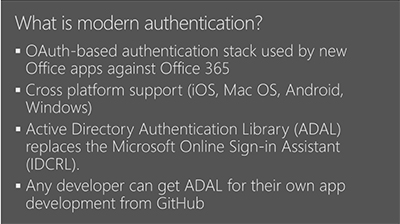News
Microsoft Updates Office 365 Modern Authentication
Microsoft's so-called "Office 365 modern authentication" feature is at the updated preview stage, per an announcement this week.
Most of the Office 365 modern authentication parts aren't ready for production environments yet, although Office 2013 and Office 2016 Windows clients have hit the "general availability" milestone. Those clients now gain the benefit of being under Microsoft's support umbrella. Office 365 modern authentication is turned on by default for Office 2016 clients. It has to be turned on, though, for Office 2013 clients.
Modern authentication is a phrase that Microsoft started using earlier this year. It concerns Office 365 client authentication using the Active Directory Authentication Library (ADAL), replacing the Microsoft Online Sign-In Assistant. From a technical standpoint, Microsoft has described modern authentication as a cross-platform OAuth-based method using ADAL for Office 365 apps, per this Microsoft Ignite session slide:
 [Click on image for larger view.]
Microsoft's definiton of "modern authentication." Source: Ignite 2015 session.
[Click on image for larger view.]
Microsoft's definiton of "modern authentication." Source: Ignite 2015 session.
The Office 365 modern authentication technology is designed to work with various Office client applications, such as Excel, PowerPoint, Word and OneNote. It's also designed to work at the client level with Office 365 services, such as Exchange Online, SharePoint Online and Skype for Business Online.
However, Office 365 modern authentication has lots of moving parts. Plenty of its capabilities are yet to come, and so Microsoft still describes it as being at the preview stage. It doesn't work by default yet with Exchange Online and Skype for Business Online clients, for instance.
Some clients just won't get Office 365 modern authentication support at all. Microsoft's announcement indicated that there are no client support plans for Office 2010, Office 2007, Office for Mac 2011, Windows Phone 7 and "older" Android and iOS clients.
To add to the confusion, Office 365 modern authentication is rebranded product terminology. It used to be called "Office 2013 modern authentication," per Microsoft's announcement.
About the Author
Kurt Mackie is senior news producer for 1105 Media's Converge360 group.